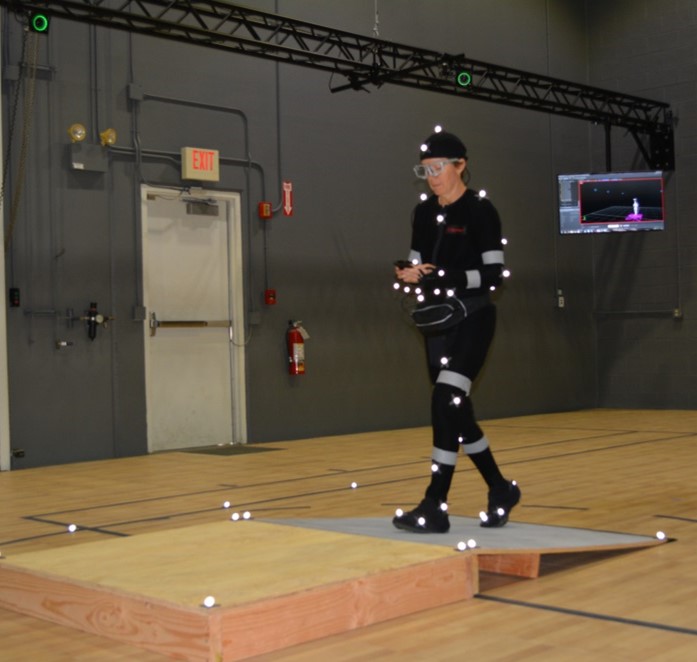Technology Advances Affecting Walking and DrivingThe proliferation of mobile technology and its use while performing other everyday tasks has become increasingly widespread. It is now commonplace to use a mobile device while engaging in other, often safety-critical, activities, such as driving and walking. Think about how often you have observed a driver or pedestrian staring at or talking on a cell phone or some other mobile device while driving or walking. Decades of research have demonstrated behavioral detriments associated with distracted driving (e.g., slower reaction times, poorer visual scanning). Approximately a quarter of automobile accidents are associated with cell phone usage.[1] Further, most states have some regulation limiting mobile device use while driving. More recently the effects of distracted walking have garnered increased attention. In 2015 the National Safety Council added distracted walking to its annual report of unintentional deaths and injuries[2] and there have been many reports of the media about people walking into or tripping over objects and falling off train platforms while using mobile devices. These have led to serious injuries and deaths – for example, a man fell off a cliff while taking a photo with his phone.[3] The potential for accidents and safety implications resulting from distracted behavior underscore the importance of providing insight and understanding regarding underlying human factors principles relevant to our ability to successfully engage with mobile technology while driving and walking. Distracted Driving and Walking Principles Human factors analysis can help explain how distraction leads to incidents by looking at cognitive and perceptual underpinnings upon which successful driving and ambulating rely. In order to operate a motor vehicle or walk in the world, human behavior is guided by a number of cognitive processes including visual perception, attention, and motor control. Walking and driving require the ongoing processing and integration of visual information while moving. People are only able to attend to a limited amount of information at any given time and distraction can cause failures in the ability to notice or detect even conspicuous objects. For example, sometimes an individual can focus his or her eyes on an object or a hazard, but still not “see” or detect it because mental resources are occupied elsewhere, and thus not adequately engaged in the additional perceptual processing required to become aware of the object.[4] While successfully deployed attention is necessary for accident and injury avoidance; it alone is not sufficient. There must also be adequate time for the person to detect an object and execute an appropriate response. Specifically, with walking, additional factors must be considered, such as looking behavior, foot falls, or gait change to see how distraction related changes might contribute to the potential for slips, trips, and falls, or their avoidance. Pedestrians often change their visual fixation and scanning patterns,[5] and based on acquired information, such as detected obstacles, modulations to gait can occur. Such modifications include avoidance maneuvers, adjustments to step length, width, and/or ground clearance and changing direction of gait, rotation of the body, or stopping.[6] Any time that a person is engaged in a potential distraction, there is a reduction in available cognitive resources for the primary task. Research has shown that a distracted driver has slower responses and higher non-response rates to critical events and hazards, decreased ability to safely negotiate gaps in traffic, and reduced scanning behavior.[7] Likewise, pedestrians have been demonstrated to engage in less safe intersection crossing behaviors while using mobile devices, including crossing more slowly, looking at obstacles and hazards less often, and exhibiting poorer gait consistency.[8] Reactions to Distracted Driving and Walking In response to the increasing incidence of accidents involving distraction due to mobile device use, laws have been enacted aimed at discouraging such behavior, particularly for drivers. According to the Insurance Institute for Highway Safety[9], as of July 2016, 14 states and the District of Columbia have banned talking on a hand-held cellphone while driving, 46 states and the District of Columbia have banned text messaging while driving, and many localities have enacted their own bans on cellphone use or text messaging while driving. One New Jersey town (Fort Lee) established a law in 2012, allowing tickets for “dangerous walking” to be issued, to include texting and walking.[10] As a playful commentary on the phenomenon of cellphone-distracted pedestrians (sometimes referred to as “pedtextrians”), several locales have introduced separate painted lanes on the ground for pedestrians using phones.[11] Notably, officials for those projects noted that most people did not obey the lanes, and many did not even notice them (often, ironically, due to being occupied by their phones). Exponent’s Distracted Driving and Walking Research Exponent has conducted research specifically aimed at characterizing the changing nature of driving, with the advent of Advanced Driver Assistive Systems (ADAS) in vehicles as well as how mobile technology use while walking can lead to changing behavior on foot. With respect to driving, the issue of distraction has been long-studied; however, recent advances in autonomous and semi-autonomous vehicle technology are changing the role of the driver in the vehicle. Specifically, safety systems are being introduced into vehicles aimed at combatting the negative effects of driver distraction by having the vehicle take over if and when the driver does not respond quickly enough. For example, if a driver fails to brake in response to hazard in front of his vehicle, whether because he is distracted or for any other reason, a vehicle with autonomous braking can automatically apply the brakes and either avoid or minimize the severity of a collision. Our on-road, closed-course experiments, which required participants to drive with ADAS technologies while performing different types of distracting tasks (i.e., talking or texting on a cell phone), showed that these technologies are helpful at mitigating some, but not all of the effects associated with distractions. Our findings indicate that ADAS have the potential to reduce the number and severity of collisions on the roadway, but are not a replacement for attentive driving. In another study, the use of lane departure warnings was not sufficient to help distracted drivers maintain their lane position – distracted drivers did not show an improvement in lane-keeping while using the lane departure warning system. This research has confirmed many of the negative effects associated with distraction while showing that recent advances in vehicle technology may help mitigate some of these effects, but it also demonstrates that these technologies are not a replacement for attentive drivers.[12] We have also been engaged in studying mobile device use and ambulation, demonstrating that walking while using mobile devices leads to changes in how we walk – both visually and in gait. In one experiment, we tracked pedestrians eye-movements, gaze and motor behavior as they approached various obstacles (e.g., a short staircase, a curb) while either texting or not texting (Figure 1).[13]
Figure 1. Participant texting in our motion capture laboratory with eye-tracker. While texting, participants scanned a narrower area, and spent less time looking at obstacles as they approached (Figure 2), suggesting that mobile device use can reduce pedestrians’ visual attention to important areas along their travel path, which may lead to a reduced awareness of the characteristics of the environment. Another study utilizing motion capture technology to characterize pedestrians’ movements and gait while either texting, talking, or not using a cellphone showed that, while texting people walked slower and had shorter strides than while not using a phone.[14] Taken together, studies, such as these, provide valuable insight into how mobile device use affects human behavior relevant to ambulation and obstacle avoidance, and can be used to help understand why falls happen and the role of the human in those accidents
Figure 2. Average time spent looking at a curb surface ahead when walking without texting (blue) and when walking while texting (orange) What this means for accident investigation and litigation? Understanding the effects of distraction is actually the application of a combination of many traditional human factors principles. The proliferation of mobile technology has dramatically increased the prevalence of distraction-related accidents, leading to an increase in public attention and intensifying the need for investigation. Our own research has shown how new technology is changing the nature of driving and walking, in such areas as movement control and visual behavior. As human factors scientists, we can integrate this into our analyses of accident causation, and help explain to juries how these human factors may have contributed to an accident. Understanding the effects of mobile device use on attention and perception is essential for understanding the human factors of a case. References Cades, D.M., Crump, C., Lester, B. D., Reed, S., Barakat, B., Milan, L. & Young D. (2016). Differing Perceptions of Advanced Driver Assistance Systems (ADAS). To be in Proceedings of the Human Factors and Ergonomics Society Annual Meeting. Crump, C., Cades, D.M., Rauschenberger, R., Hildebrand, E., Schwark, J., Barakat, B., & Young, D. (2015). Driver Reactions in a Vehicle with Collision Warning and Mitigation Technology (No. 2015-01-1411). SAE Technical Paper. Hatfield, J., & Murphy, S. (2007). The effects of mobile phone use on pedestrian crossing behaviour at signalised and unsignalised intersections. Accident Analysis & Prevention, 39(1), 197-205. Insurance Institute for Highway Safety (2016, July). Distracted Driving. Retrieved from http://www.iihs.org/iihs/topics/laws/cellphonelaws/ Kaplan, S. (2015, June 17). Texting while walking? There’s a lane for that. Retrieved from https://www.washingtonpost.com/news/morning-mix/wp/2015/06/17/texting-while-walking-theres-a-lane-for-that/ Kim, R., Lester, B. D., Schwark, J., Cades, D. M., Hasish, R., Moorman, H. & Young, D. (2016). Gaze behavior during curb approach: The effect of mobile device use. To be in Proceedings of the Human Factors and Ergonomics Society Annual Meeting. Lanagan‐Leitzel, L. K., Skow, E., & Moore, C. M. (2015). Great expectations: Perceptual challenges of visual surveillance in lifeguarding. Applied Cognitive Psychology, 29(3), 425-435. Lester, B. D., Hashish, R., Kim, R., Moorman, H., Hildebrand, E., Rauschenberger, R., & Young, D. (2016). Mobile device usage influences gaze patterns to obstacles during locomotion. Industrial & Systems Research Conference. Anaheim, CA. Marigold, D. S. (2008). Role of peripheral visual cues in online visual guidance of locomotion. Exercise and Sport Sciences Reviews, 36(3), 145-151. Matyszczyk, C. (2016, March 27). Will this state ban texting while walking? Retrieved from http://www.cnet.com/news/state-politician-moves-to-ban-texting-while-walking/ National Safety Council (2016). Take steps to avoid injury or death while walking. Retrieved from http://www.nsc.org/learn/safety-knowledge/Pages/news-and-resources-pedestrian-safety.aspx Ngak, C. (2012, May 15). Texting while walking banned in N.J. town. Retrieved from http://www.cbsnews.com/news/texting-while-walking-banned-in-nj-town/ Neider, M. B., Gaspar, J. G., McCarley, J. S., Crowell, J. A., Kaczmarski, H., & Kramer, A. F. (2011). Walking and talking: dual-task effects on street crossing behavior in older adults. Psychology and aging, 26(2), 260. Patla, A. E. (1997). Slips, trips and falls: Implications for rehabilitation and ergonomics. Perspectives in rehabilitation ergonomics, 196-209. Patla, A. E., & Vickers, J. N. (1997). Where and when do we look as we approach and step over an obstacle in the travel path? Neuroreport, 8(17), 3661-3665. Perlmutter, S., Cades, D. M., Heller, M. F., Giachetti, R., Arndt, S. R., & Sala, J. B. (2014, September). Effects of mobile technology use on walking. In Proceedings of the Human Factors and Ergonomics Society Annual Meeting (Vol. 58, No. 1, pp. 2166-2170). Sage Publications. Recarte, M. A., & Nunes, L. M. (2000). Effects of verbal and spatial-imagery tasks on eye fixations while driving. Journal of experimental psychology: Applied, 6(1), 31. Strayer, D. L., Watson, J. M., & Drews, F. A. (2011). 2 Cognitive Distraction While Multitasking in the Automobile. Psychology of Learning and Motivation-Advances in Research and Theory, 54, 29. Tatro, S. & Fleming, O. (2015, December 28). Man, distracted by electronic device, identified after falling to death at Sunset Cliffs. Retrieved from http://www.nbcsandiego.com/news/local/Man-Dies-After-Falling-Off-Cliff-at-Sunset-Cliffs-Lifeguards-363534491.html/ [1] National Safety Council, 2016 [2] National Safety Council, 2016 [3] Tatro & Fleming, 2015 [4] Lanagan-Leitzel et al., 2015 [5] Patla, 1997 [6] Patla & Vickers, 1997; Marigold, 2008; [7] Strayer et al., 2011; Recarte & Nunes, 2000; [8] Neider et al., 2010; Hatfield & Murphy, 2007 [9] IIHS, 2016 [10] E.g., Ngak, 2012 [11] E.g., Kaplan, 2015 [12] For more details see: Cades et al., 2016; Crump et al., 2015 [13] Kim et al., 2016; Lester et al., 2016 [14] Perlmutter et al., 2014 |















